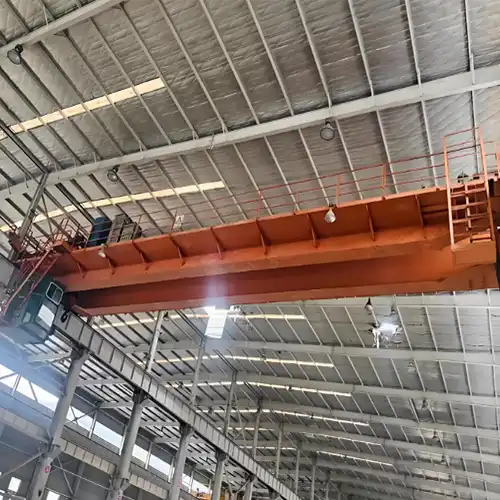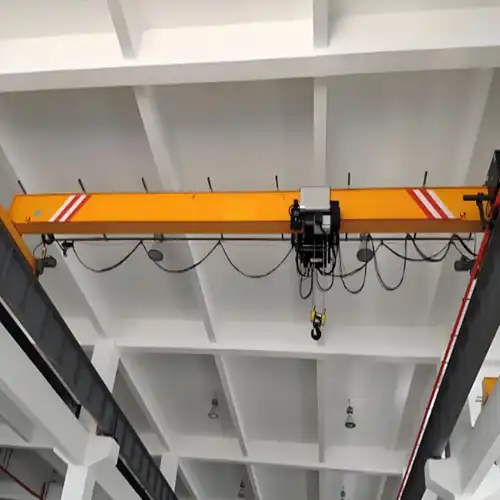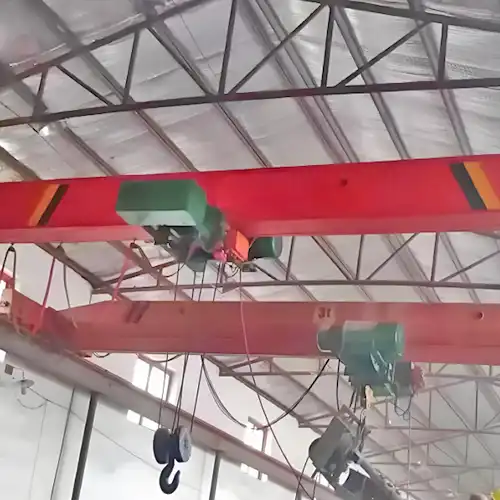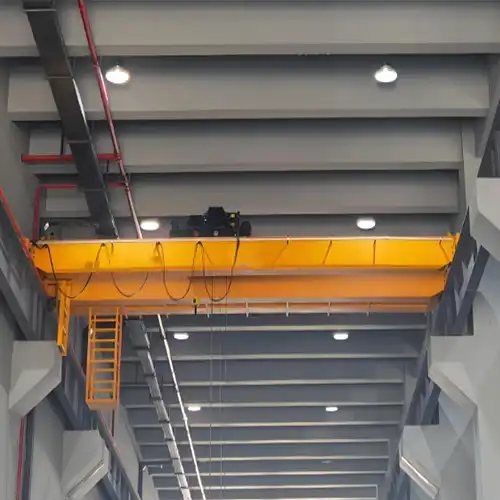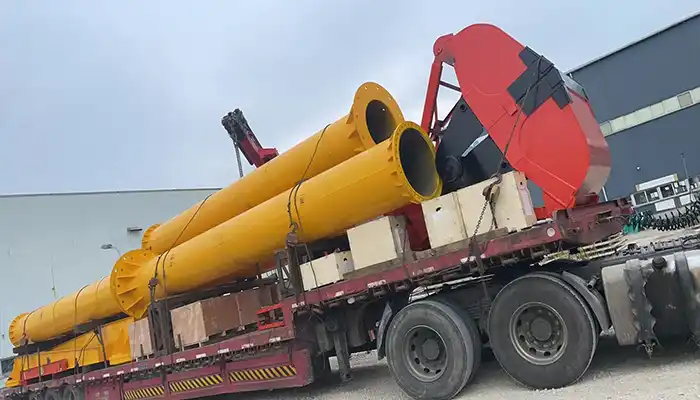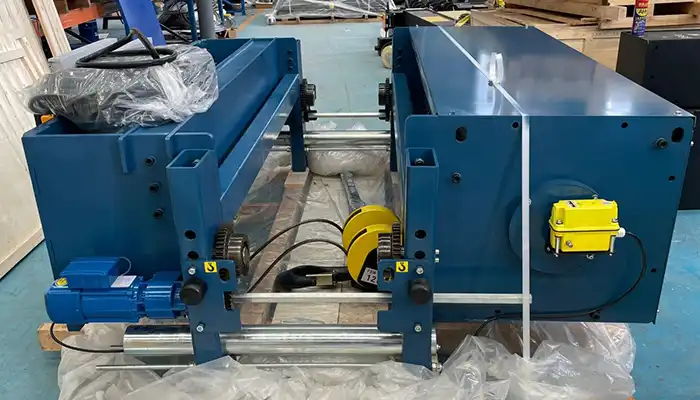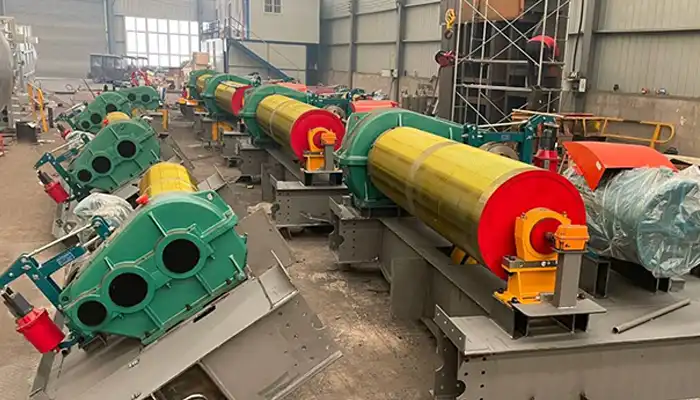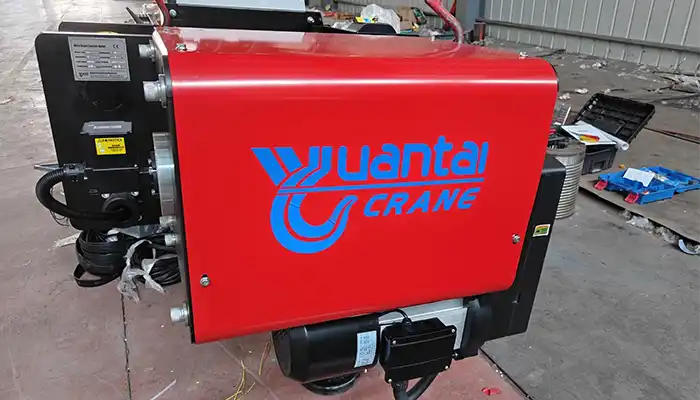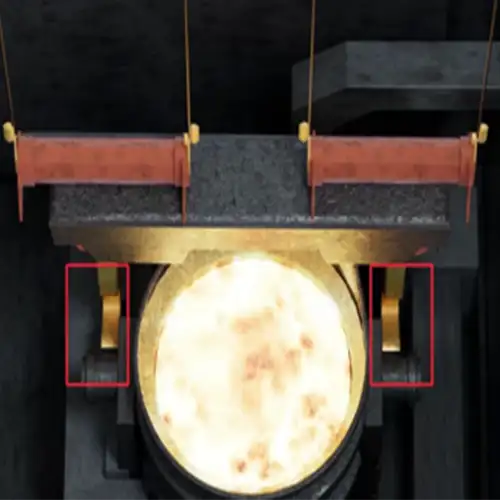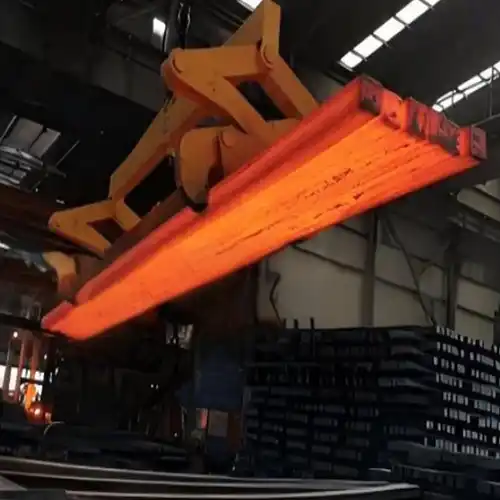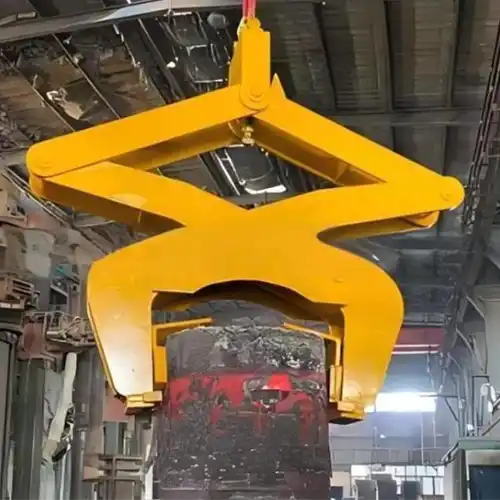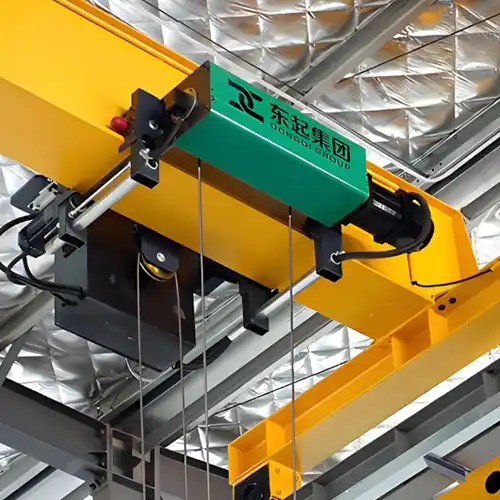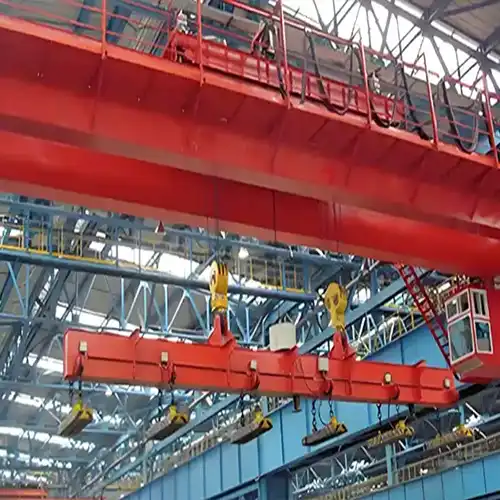15 Ton Overhead Cranes Optimizing Space in Steel Mills Argentina
Compact 15 Ton overhead cranes for limited space workshops in Argentina’s steel mills, enhancing productivity & workflow.Low headroom bridge crane for you!
Category: Argentina
Your Trusted Overhead Crane Manufacturer & Supplier
15 Ton Overhead Cranes Optimizing Space in Steel Mills Argentina
Compact 15 Ton overhead cranes for limited space workshops in Argentina's steel mills, enhancing productivity & workflow.Low headroom bridge crane for you!
15 Ton Overhead Bridge Cranes Optimizing Space in Argentina's Steel Mills
Overview of Overhead Bridge Cranes in Steel Mills
Overhead bridge cranes are essential in steel mills for moving heavy materials like raw steel, coils, and finished products. These cranes are mounted on rails along the ceiling, which frees up space on the factory floor. This makes them an important part of smooth and efficient operations in steel production.
- Key role: Lifting and transporting heavy materials across the factory
- Design: Mounted on ceiling tracks, saving floor space
- Benefit: Helps reduce delays and accidents by moving materials safely and quickly
Steel mills rely on overhead cranes to move large items with precision and safety. Without cranes, operations would be slower and more dangerous, leading to higher risks and potential delays.
Importance of Material Handling in Steel Mills
Efficient material handling is crucial for smooth steel mill operations. Moving materials correctly reduces waste and downtime, while improving productivity.
- Efficient handling: Moves materials to the right place, at the right time
- Reduced risks: Less chance of accidents or damage to materials and equipment
- Better flow: Helps maintain smooth, continuous production
Without proper material handling systems, delays and safety issues can increase. Cranes help avoid these problems by making the process safer and faster, ensuring materials are where they need to be without causing accidents.
Growing Need for Optimized Space in Argentina's Steel Production Industry
In Argentina, steel mills face growing demand and need more efficient use of their factory space. Space is limited, and mills need to maximize what they have. Optimizing space becomes more important as production expands.
- Space challenges: Factories are becoming more crowded with growing production
- Need for efficiency: Efficient space use is essential for future growth
- Solution: Compact overhead cranes help make the most of available space
Overhead cranes with compact designs are an excellent solution. They lift materials off the floor, allowing factories to use vertical space and keep the floor clear for other equipment and workers. As space becomes tighter, these cranes are helping steel mills in Argentina stay productive and grow without needing to expand their buildings.
15 Ton Low Headroom Bridge Cranes
What is a 15 Ton Low Headroom Bridge Crane?
A 15 Ton low headroom bridge crane is a specialized type of crane designed to lift and move heavy materials in industrial settings like steel mills, where space is often limited. The "low headroom" feature means that the crane is designed with a compact profile, which allows it to operate in areas with lower ceiling heights while still maintaining high lifting capacity. It consists of several key components that work together for safe and efficient material handling.
- Bridge: The primary structure of the crane that spans across the factory floor. It runs along fixed tracks mounted on the ceiling, covering a wide area for lifting and moving materials.
- Trolley: A part that moves along the bridge, holding the hoist. It travels back and forth to position the load for lifting and transport.
- Hoist: The lifting mechanism attached to the trolley. It raises and lowers materials using chains or ropes and is designed to handle heavy loads.
- Controls: The system that operators use to control the crane's movements. This includes precise controls for lifting, lowering, and shifting materials, often operated electronically for better accuracy.
These components work seamlessly together to provide efficient lifting and material movement, even in confined spaces.
Load Capacity and General Features
The 15 Ton in the name refers to the crane's load capacity, meaning it can safely lift and move loads up to 15 tons. The low headroom design is especially useful for environments with limited ceiling height but still requires the ability to lift heavy loads.
- Load Capacity: The crane can lift up to 15 tons of material, which is ideal for many tasks in steel mills, such as moving large steel beams or coils.
- Low Headroom Design: The crane's compact profile allows it to operate in environments with lower ceiling heights, maximizing available space.
- Precision: The controls and design allow for precise lifting and moving of materials, which helps avoid accidents or damage.
- Space-saving: The low headroom design allows the crane to be used in tight spaces, freeing up more floor area for other operations.
The 15 Ton low headroom bridge crane is designed to offer powerful lifting capabilities while taking up less vertical space, making it perfect for environments with limited ceiling height.
Why 15 Ton Low Headroom Cranes?
15 Ton low headroom bridge cranes are particularly well-suited for mid-sized production environments, where both space and lifting capacity are important. The combination of a compact design with a high load capacity makes these cranes versatile and effective in tight spaces.
- Ideal for limited ceiling height: The low headroom feature makes it perfect for factories with lower ceilings, allowing for efficient material handling without needing to raise the ceiling.
- Balanced capacity: With a 15-ton lifting capacity, it's strong enough for many steel mill tasks while remaining compact enough to fit in confined spaces.
- Space-efficient: The low headroom design frees up valuable floor space, allowing for more efficient layout and better material handling.
In steel mills, a 15 Ton low headroom bridge crane provides just the right amount of lifting power and is designed to optimize space, even in areas where headroom is restricted. It offers both versatility and efficiency, making it a great choice for many production needs.
The Challenge of Space in Steel Mills
Space Limitations in Steel Production
Steel mills are large, complex operations where space is often a premium. As production demands grow, so does the need for efficient use of factory floor space. Typically, steel mills have large machines, heavy equipment, and materials stored on the floor, leaving limited room for movement or expansion. These factories may have limited ceiling height or narrow aisles that make it harder to maneuver large loads.
- Factory floor size: Steel mills range from smaller facilities to vast industrial spaces, but all face limitations when it comes to maximizing space.
- Constraints: The need to fit large machines, heavy materials, and workers into a confined area creates challenges for smooth operations.
- Tight spaces: In many mills, floors are cluttered with equipment, material storage, and vehicles, reducing the room for crane movement and causing congestion.
As production lines grow, managing space efficiently becomes more difficult, and optimizing the layout of factory floors is essential to keep operations running smoothly.
Common Issues: Overcrowded Spaces, Poor Material Flow, Bottlenecks
Inefficient use of space leads to several common issues that steel mills must overcome to maintain productivity:
- Overcrowded spaces: When equipment and materials are packed too closely together, it's harder to move and transport heavy items. This can slow down production and increase the chance of accidents.
- Poor material flow: When materials are stored or moved in ways that block pathways or restrict crane movement, the production process becomes slow and inefficient. Materials may need to be moved multiple times or in the wrong order, leading to delays.
- Bottlenecks: A lack of space and poor material flow can create bottlenecks, where production is delayed because workers or machines are waiting for materials to be moved. These bottlenecks can create ripple effects that slow down the entire process.
These issues contribute to slower operations, less efficient workflows, and higher costs, all of which impact the bottom line.
Impact of Inefficient Space Utilization
When space in steel mills is not used effectively, it leads to a number of negative consequences that can hurt productivity, safety, and overall costs.
- Increased operational costs: Inefficient space utilization means more resources are required to move materials. Cranes may have to work harder, workers may need to manually move materials more often, and more equipment may be needed to handle the same amount of work. This leads to higher costs in labor, energy, and equipment maintenance.
- Safety hazards: Overcrowded spaces increase the risk of accidents. Workers have to navigate around clutter, and cranes may struggle to move materials safely through congested areas. Tight spaces can also cause issues with visibility, leading to accidents or injuries. Lack of room for movement and insufficient safety zones around equipment can increase risks for workers on the floor.
In a steel mill, every inch of space matters. Poor space utilization not only impacts productivity but also directly affects the safety and well-being of employees. Finding ways to optimize space can help reduce costs, improve safety, and increase overall efficiency.
Compact Design of Overhead Cranes
Innovations in Compact Crane Technology
Recent advancements in crane technology have made it possible to design more compact and efficient overhead cranes, ideal for steel mills with limited space. These innovations focus on creating cranes that can still lift heavy loads while taking up less vertical and horizontal space.
- Streamlined crane components: Compact cranes have been engineered with smaller, lighter parts that fit into tighter spaces without sacrificing strength or reliability. This means fewer large components that require extra space, allowing for more flexible factory layouts.
- Design modifications: The crane's structure has been modified to reduce size and weight. By using advanced materials and engineering techniques, these cranes are sleeker, more agile, and better suited to confined environments.
- Lighter components: Reduces overall weight, improving energy efficiency and crane maneuverability.
- More agile: These cranes can move more freely and efficiently through narrow aisles and small spaces, making them perfect for mills with limited floor space.
These design innovations help create cranes that are not only powerful but also adaptable to modern factory needs where space optimization is crucial.How Compact Cranes
Save Space
Compact overhead cranes help steel mills maximize their available space, making them especially useful in environments where floor space is limited. They are designed to reduce the overall footprint of the crane system while maintaining high performance.
- Reduced operational footprint: Compact cranes take up less floor space than traditional cranes, allowing for more room to store materials or place other equipment. This frees up valuable factory floor space for other essential operations, like production lines and storage.
- Lifting capacity with minimal structural intrusion: Despite their smaller size, 15-ton low headroom cranes can handle heavy loads without requiring significant changes to the factory's existing structure. They are built to provide full lifting power while occupying less space in terms of height and width.
- Higher ceiling utilization: By lifting materials off the ground and utilizing vertical space, compact cranes maximize the available height in a factory. This helps free up the lower levels of the factory floor for other operations, like material storage, while still providing the necessary lifting capabilities.
- Optimized workflows: With a compact crane design, mills can streamline material movement and improve the overall workflow. The smaller footprint means less congestion, fewer obstacles, and smoother transitions between production stages.
Optimizing Factory Space with 15 Ton Overhead Cranes
Better Utilization of Factory Floors
15 Ton overhead cranes are designed to optimize space, especially in steel mills with limited factory floor area. Their compact design allows them to be placed in areas where traditional cranes might not fit, helping mills use their space more efficiently.
- Flexibility in placing cranes: These cranes can be positioned across tighter spaces, allowing for a more flexible layout. This means that even in mills with limited floor space, cranes can be placed in ways that maximize their utility without overcrowding the factory.
- Efficient movement in confined areas: With their streamlined design, compact cranes can move materials easily within narrow aisles and crowded spaces. This allows for smooth operations even in areas where large equipment would struggle.
- Maximizing vertical space: 15 Ton overhead cranes can utilize the full height of the factory, lifting materials higher up to free up floor space for storage or other tasks. By using vertical space, the crane can move materials from storage areas to production lines without causing congestion on the factory floor.
By optimizing the placement and movement of overhead cranes, steel mills can free up valuable space, allowing for better organization and smoother workflows.Enhanced
Material Handling
Overhead cranes not only help with space efficiency but also improve how materials are handled, making production processes faster and more accurate.
- Improved crane precision and control: Modern 15 Ton cranes offer enhanced control systems that allow operators to move heavy loads with precision. This minimizes errors and ensures materials are placed exactly where they are needed, improving overall efficiency.
- Faster transitions from production to storage: With their ability to move materials quickly and accurately, these cranes help reduce the time spent moving products from one stage to another. This speeds up production and minimizes downtime.
- Reduction in human labor and error: By automating much of the material handling process, cranes reduce the need for manual labor. This lowers the risk of human error, making the entire process safer and more efficient.
These improvements in material handling contribute to a smoother, faster production process, helping steel mills maintain high levels of productivity.
Reduced Congestion and Clutter
Compact overhead cranes can help reduce the clutter and congestion that often arises in busy steel mills, resulting in better organization and safer working conditions.
- Decrease in manual tools and forklifts: With overhead cranes taking over much of the material movement, there is less need for manual tools or forklifts on the floor. This reduces the number of vehicles and equipment needed to move materials, cutting down on clutter.
- Clearer pathways for workers: With fewer obstacles in the way, workers can move around more easily. The open space helps improve safety by reducing the chances of accidents or collisions.
- Smoother operations: The combination of a more organized workspace and efficient crane movement leads to smoother operations. Workers and equipment can perform their tasks without being hindered by a cluttered or congested factory floor.
Key Benefits of Compact Overhead Cranes with Low Headroom Design
Increased Productivity and Efficiency
Compact overhead cranes with low headroom design significantly improve productivity and efficiency in steel mills by optimizing how materials are moved and handled.
- Faster material handling: These cranes reduce the time spent on moving heavy materials between production stages. The speed and precision with which they operate translate into quicker workflows and higher throughput.
- Reduced downtime: With their advanced design, low headroom cranes operate smoothly, minimizing delays caused by equipment malfunctions or space constraints. Their efficient use of space and reliable performance ensures that cranes spend less time out of action, leading to continuous operations.
- Lower risk of accidents and injuries: With fewer obstacles on the factory floor and clearer pathways for workers, the risk of accidents decreases significantly. The streamlined movement of the crane also reduces the chances of collisions with other equipment or workers.
- Greater precision in heavy lifting: Low headroom cranes offer superior control, which means heavy loads are lifted and placed with greater accuracy. This reduces the likelihood of mistakes that could lead to accidents, such as loads being dropped or improperly positioned.
The improved workflow and precise lifting make it easier for workers to navigate the factory safely, lowering the risk of accidents and creating a more secure work environment.
Cost Savings
Investing in compact overhead cranes with low headroom design leads to several cost-saving benefits for steel mills, both in terms of operational costs and equipment longevity.
- Lower operational costs: By optimizing factory layouts and reducing the need for additional equipment like forklifts or manual tools, these cranes help cut operational expenses. They move materials more efficiently, reducing labor costs and energy consumption.
- Extended crane lifespan: The advanced design and high-quality materials used in low headroom cranes ensure that they last longer and require less maintenance. The efficient operation of the crane reduces wear and tear, which translates into fewer repairs and longer service life.
value for steel mills.These key benefits—higher productivity, improved safety, and cost savings—make compact overhead cranes with low headroom design a valuable asset for steel mills, helping them improve their operations and stay competitive in a demanding industry.
Case Studies: Argentina's Steel Mills & Compact Cranes
Examples of Successful Crane Integrations
Several steel mills in Argentina have successfully integrated compact 15 Ton overhead cranes with low headroom design into their operations, significantly improving their space utilization and material handling efficiency.
- Steel Mill A (Buenos Aires): This steel mill faced major space constraints as production volumes increased. By installing compact 15 Ton cranes, the facility was able to free up valuable floor space. The cranes' ability to lift materials vertically and move them efficiently across tight aisles led to smoother operations and faster production cycles.
- Steel Mill B (Rosario): After implementing low headroom cranes, this mill saw a noticeable reduction in material handling time. The cranes' precision allowed for faster transitions between production stages, reducing downtime and boosting throughput. The clear and organized layout also improved worker safety by reducing obstacles on the factory floor.
- Space usage: Factory floors were optimized by reducing clutter and improving material storage.
- Material handling: Faster and more efficient handling of heavy loads led to higher production rates and quicker order fulfillment.
- Safety: With fewer obstacles and improved crane control, the risk of accidents decreased, ensuring a safer working environment for employees.
These case studies highlight how compact 15 Ton cranes have helped Argentine steel mills operate more efficiently, safely, and cost-effectively.
Challenges Faced During Implementation
While the integration of compact 15 Ton cranes brought significant improvements, some challenges were encountered during the implementation process.
- Overcoming initial space layout resistance: Many mills initially struggled with the idea of changing their established factory layouts to accommodate the new cranes. Some workers and managers were hesitant to modify long-standing processes and floor plans. However, after seeing the potential benefits, including improved space utilization and faster material handling, the resistance decreased.
- Ensuring crane integration with existing infrastructure: Another challenge was ensuring the cranes could be integrated with the existing mill infrastructure. Steel mills often have heavy machinery, storage systems, and existing overhead tracks in place. The compact cranes had to be customized to work alongside these structures without causing disruptions. This required careful planning, but once integrated, the cranes fit seamlessly into the production environment.
Future of Overhead Cranes in Argentina's Steel Industry
Innovations on the Horizon
The future of overhead cranes in Argentina's steel industry is filled with exciting advancements that promise to further optimize operations and enhance performance. These innovations are focused on improving crane control, automating processes, and incorporating new technologies to create smarter, more efficient systems.
- Advancements in automation and AI for crane control: Automation is set to revolutionize crane operations. Artificial intelligence (AI) and machine learning will be integrated into crane control systems to optimize material handling, predict maintenance needs, and improve precision. Automated cranes will be able to move loads without direct human intervention, leading to even faster and more accurate material handling.
- Further space-saving designs and integrated technologies: As mill operations grow, there will be a greater need for cranes that save space while delivering maximum performance. Future overhead cranes will feature more compact designs, reduced structural elements, and smarter integration with other systems, such as automated storage solutions and real-time tracking technology.
- Sustainability improvements through optimized resources: Advanced overhead cranes will improve resource efficiency in steel mills. With optimized space usage, reduced energy consumption, and more accurate material handling, mills will reduce waste and lower their environmental impact. Automation will also help monitor resource consumption more closely, further enhancing sustainability.
- Shaping Argentina's competitiveness in global steel markets: The adoption of advanced crane technology will help Argentina's steel mills become more competitive in the global market. By improving efficiency, reducing costs, and increasing output, mills will be able to meet growing international demand while remaining cost-effective. The ability to integrate cutting-edge technology will make Argentine steel more attractive to global buyers, strengthening the country's position as a leading player in the steel industry.
Conclusion
Summary of the Role of 15 Ton Overhead Bridge Cranes in Optimizing Space
15 Ton overhead bridge cranes with low headroom design play a pivotal role in optimizing space within steel mills, where efficiency, safety, and productivity are paramount. By taking up less space while maintaining high lifting capacity, these cranes allow steel mills to maximize their factory floor layout, streamline material handling, and reduce congestion. The ability to operate in confined areas and lift materials vertically helps mills make the most of their available space, leading to improved workflows, reduced operational costs, and a safer working environment. These cranes are not only effective in boosting efficiency but also essential for creating a more organized and sustainable production process.
Looking Ahead: Opportunities for More Widespread Adoption
As the benefits of compact crane technology become increasingly evident, there is a growing opportunity for more steel mills, both in Argentina and globally, to adopt these advanced systems. The success stories of mills that have already integrated 15 Ton overhead cranes highlight the potential for wider adoption across the industry.
- Encouraging more steel mills: By showcasing the positive impact of compact cranes on productivity, safety, and cost savings, more mills will be encouraged to explore these technologies. The integration of compact cranes with automation and AI offers additional possibilities for optimization, further enhancing their appeal.
- Paving the way for a more productive and sustainable steel manufacturing environment: With the continued development of innovative crane technologies and the growing need for space efficiency, the future of steel manufacturing looks promising. The widespread adoption of compact cranes will not only improve productivity and safety but also contribute to sustainability by reducing energy consumption, resource waste, and environmental impact.
Main Projects
Related Products
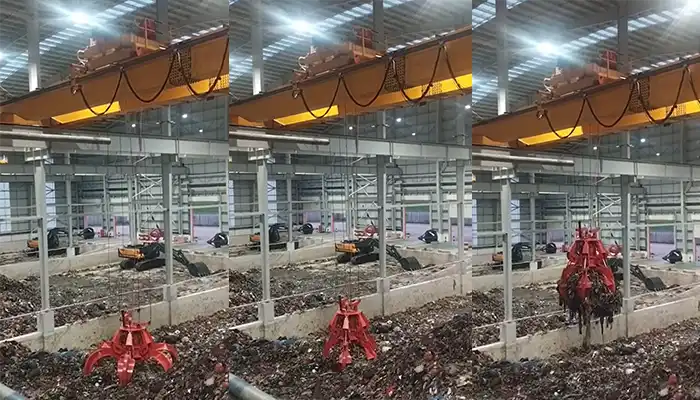
Supplied three grab bucket crane kits to Indonesia, enhancing garbage handling efficiency with high load capacity and reliable performance.
Free consultation to Confirm Parameters & Specifications and Get
Latest Crane Price & Crane Rate.
- Types of overhead cranes : _______?
- Optional: Overhead travelling crane, goliath gantry crane,Slewing jib crane, Single girder or double girder crane,small portable crane or kbk crane, etc.
- Capacity of overhead crane: _______?
- Optional: 0.25ton, 0.5 ton, 1 ton, 2 ton, 3ton, 5 ton, 10 ton,15ton, 20ton, 25 ton, 30ton,35ton, up to 550ton, etc.
- Crane span & lifting height : _______?
- Crane travelling length : _____?
- Control of overhead crane:_______?
- Optional: pendant/ remote/cabin control
- Voltage supply of overhead crane:_____?
- Eg,: 380V50/60HZ,3Phase or others,etc.
- Application/usage of crane:_______?
- Eg,: Steel mill, ,injection mold, cement,stone, concrete,granite, general manufacturing, etc.
Just leave a message via the contact form and our hoist and crane engineer will contact you with in 24working hours.
Get In Touch
